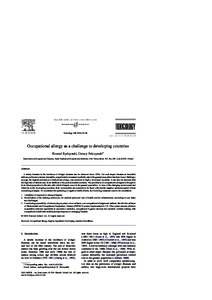Occupational allergy as a challenge to developing countries

Rydzynski, Konrad ; Palczynski, Cezary
2004
198
1-3
75-82
allergies ; asthma ; atopy ; dermatitis ; frequency rates ; medical surveillance ; preventive medicine
Occupational safety and health
English
Bibliogr.
"A steady increase in the incidence of allergic diseases can be observed since 1950s. For such atopic diseases as bronchial asthma, pollinosis or atopic dermatitis, a significantly increased morbidity rate in the general population has been found. Strikingly enough, the highest prevalence of asthma and allergy was recorded in highly developed countries. It can thus be assumed that the high rate of asthma may be an attribute of the post-industrial societies. The prevalence of occupational allergies is thought to be in direct proportion to the rate with which allergies occur in the general population. In view of the changing environment and lifestyles in the developing countries, their communities are expected to be faced with similar negative epidemiological effects concerning allergies. To counteract the spreading of negative health effects, the following measures need to be undertaken:
1. Limitation of exposure to strongallergens.
2. Modification of the training curriculum for medical personnel and of health service infrastructure, according to new tasks and challenges.
3. Considering a possibility of introducing a system of surveillance over occupational allergies and asthma, like the Surveillance of Work-related and Occupational Respiratory Disease (SWORD) system implemented in UK. This system ensures effective cooperation between specialists in preventive medicine, occupational hygiene services and research workers dealing with occupational health that enables prompt response to emerging hazards."
Digital
The ETUI is co-funded by the European Union. Views and opinions expressed are however those of the author(s) only and do not necessarily reflect those of the European Union or the ETUI.